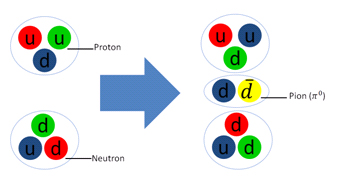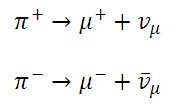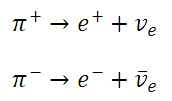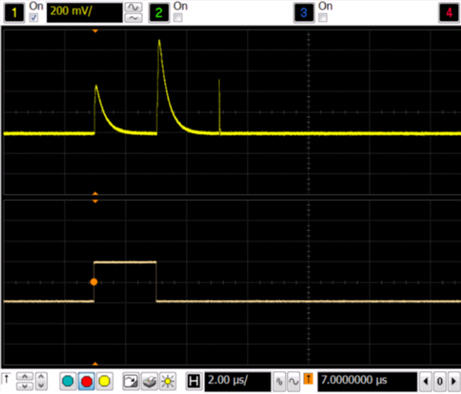

Background
Particle physics research institutes are trying to simulate and research the behavior of sub-atomic particles. A Pion is any of three sub-atomic particles : . Each Pion consists of a Quark and an Anti-quark and is therefore a Meson. Pions are the lightest Mesons, because they are composed of the lightest Quarks. Because Pions consists of a particle and an antiparticle, they are very unstable, with the Pions
. Each Pion consists of a Quark and an Anti-quark and is therefore a Meson. Pions are the lightest Mesons, because they are composed of the lightest Quarks. Because Pions consists of a particle and an antiparticle, they are very unstable, with the Pions  decaying with a mean lifetime of 26 nanoseconds (2.6×10−8 seconds), and the neutral Pion
decaying with a mean lifetime of 26 nanoseconds (2.6×10−8 seconds), and the neutral Pion  decaying with a much shorter lifetime of 8.4×10−17 seconds.
decaying with a much shorter lifetime of 8.4×10−17 seconds.

Figure 1: Nuclear force interaction
Requirement
The primary decay mode of a Pion, with probability 0.999877, is a purely Leptonic decay into an anti-Muon and a Muon Neutrino.

The second most common decay mode of a Pion, with probability 0.000123, is also a Leptonic decay into an Electron and the corresponding Electron anti-Neutrino. This "electronic mode" was discovered at CERN in 1958.

Also observed, for charged Pions only, is the very rare "Pion beta decay" (with probability of about 10−8) into a neutral Pion plus an Electron and Electron anti-Neutrino.
The  Pion decays in an electromagnetic force process. The main decay mode, with a branching ratio BR=0.98823, is into two photons:
Pion decays in an electromagnetic force process. The main decay mode, with a branching ratio BR=0.98823, is into two photons:

The second most common decay mode is the “Dalitz decay” (BR=0.01174), which is a two-photon decay with an internal photon conversion resulting a photon and an electron-positron pair in the final state:

Also observed for neutral Pions only, are the very rare “double Dalitz decay” and the “loop-induced decay”.
The rate at which Pions decay is a prominent quantity in many sub-fields of particle physics, such as Chiral-Perturbation theory. This rate is parametrized by the Pion decay constant  , related to the wave function overlap of the Quark and anti-Quark.
, related to the wave function overlap of the Quark and anti-Quark.
In their work, researchers in the field of particle physics are looking for ways of simulating pion decay, and this is where the need for an Arbitrary Waveform Generator arises.
Solution
Tabor Electronics’ WX2181/2C model with the ArbConnection Software provides endless capabilities for creating and shaping arbitrary waveforms. The WX2181/2C is a high speed Arbitrary Waveform Generator with a 2.3GS/s SCLK that can provide a bandwidth of up to 1GHz. The unit has a typical rise time of 600ps and can reach amplitudes of up to 4Vpp. The WX series offers excellent signal quality and dynamic range, with harmonic distortion <-70dBc, non-harmonic distortion < -80dBc and very low phase noise of -120 dBc at 10kHz offset.

Figure 2: Simulations of pion decay
The unit also offers up to 32Mb per channel of waveform memory that enables the generation of user defined arbitrary waveform, sequences and advanced sequences. Combined with advanced triggering capabilities that enable conditional jumping, nesting and looping it can generate extremely long and complex scenarios.
The Pion decay simulations can be created using the ArbConnection, which is a remote control software, provided free of charge by Tabor Electronics, that allows the user to unleash the virtually unlimited waveform generation capabilities built into the the WX2181/2C.

For More Information
To learn more about Tabor’s solutions or to schedule a demo, please contact your local Tabor representative or email your request to [email protected].